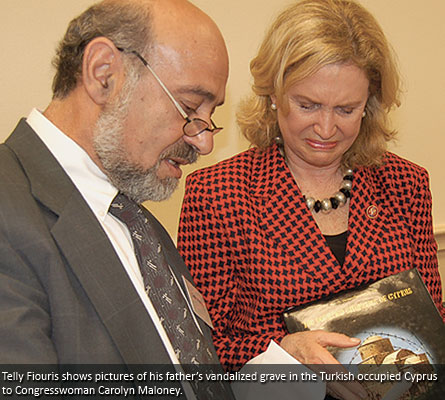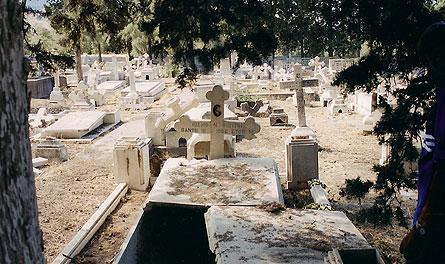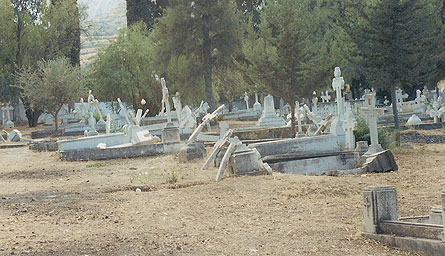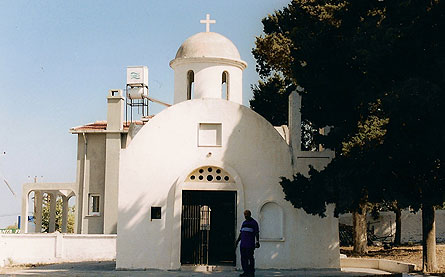The real face of Turkish occupation in Cyprus
By Demetrios Rhompotis
Telly Fiouris hardly cuts the figure of a lobbyist, but he certainly became one, albeit unwillingly, after witnessing firsthand the ugliness and barbarity of the 1974 invasion in Cyprus. And he was reminded of that while visiting his father’s grave a few years ago in the village of Karavas.

“Some relatives had gone before me and they saw that my father’s grave was open,” he says, lowering his eyes over a demitasse of Greek coffee. “I didn’t believe that …So, I went there myself and yes, I found the grave open and empty. I only found a bone, probably a part of the arm, anything else wasn’t there …I got sick from it, very depressed, but I managed to take some pictures and I couldn’t wait to come back to the US.”
Participating in the annual PSEKA (World Coordinating Committee for Justice in Cyprus, from its initial in Greek) conference, held May of every year in Washington DC, became for Mr. Fiouris an annual pilgrimage, a duty, which will not abandon until justice is done. With several photos in his hand, he will approach every senator or representative who comes by and show them the toll the Turkish invasion in Cyprus had not only on the living but also on the …dead!

“Other graves were in the same or worse condition. The church door was missing, the icons were gone and there were human remains in it, another thing that made me sick, people to have used a sacred place as a toilet!”
He is currently looking for ways to pass the material to Evangelical communities throughout the US. “I don’t know how to use computers and I have to depend on other people. It’s kind of hard for me, but I’m not gonna stop”.
Asked about the legislators’ reaction, Mr. Fiouris, a very humble but iron-willed man, who was born in Cyprus an American citizen, grew up in Jersey and now lives in Florida, “most of them were shocked and outraged,” he says. “Some asked me for copies of the photos and other information.” As in everything, there was an exception, though. “Only one, Congressman Robert Wexler (D-FL), the co-founder of the Turkish Caucus in Congress, when he looked at the pictures and I told him what were about, ‘So what,’ he answered! I replied to him that I am very sorry you are a representative of the American people. Coming from you this answer is not acceptable. He then ran away. (This reporter witnessed the exchange.) This year I’m going to find out whether Mr. Wexler had a change of mind. This is an election year and I hope that he’s not making it if he hasn’t changed his attitude. And I’ll work for that in Florida.”

To his credit, Congressman Wexler has asked the Turks to significantly reduce the number of 43,000 occupying forces on the north of the island that equal to one third of the area’s indigenous population!
Mr. Fiouris’ adventure in trying to visit his occupied village started long before crossing to the occupied areas was permitted. “I was trying for 28 years to go to my father’s (Joseph) grave, which is in Karavas, part of the occupied prefecture of Keryneia.” He did contact his area’s congressmen and senators but to no avail. Then, Senators Toricelli from New Jersey and Barbara Mikulski from Maryland gave him letters and instructed him to go to the American Embassy in Nicosia to see if they can help go across the division line.
“They turned their back on me. They told me they had no jurisdiction, to sign papers etc…They just pushed me away and they told me it was something that I had to do on my own.”

He did it four years ago, when some crossings opened. Last year, he decided to visit the house of his early youth, in which other people dwell since the invasion of 1974. “A Turkish fellow from Paphos is living now with his family in my house, which by the way, my mother had given to my sister after my father’s death. He offered to let me go upstairs to my room, where I used to sleep, but I didn’t take on the offer. Instead I went around and looked outside. He made me feel at home when I went there, and he believes that some day he will go back to his home too. He himself had problems with the ones who came from Turkey.”
Today the number of illegal settlers (over 160,000) that Turkey brought in exceeds the population of the Turkish speaking Cypriots, the majority of which was forced to seek a better fortune in England, the US and whatever other country they could go to, except Turkey. On top of that, more than 43,000 Turkish soldiers, heavily armed, are stationed in the occupied area, creating, according to the UN Secretary-General, “one of the most militarized regions of the world”.
The damage on Cypriot culture and monuments has been …monumental! Evidently, the effort to wipe out the religious and cultural heritage in the northern part of Cyprus, is systematically carried out and acts of vandalism as the case with Mr. Fiouris’ father grave indicate, are condoned if not tacitly encouraged.
Byzantine churches, monuments and antiquities were destroyed or looted and many items were smuggled abroad.
Sadly, the island's cultural heritage that reaches back to the 7th millennium B.C. and is part of the common heritage of mankind continues to this day to be systematically and deliberately destroyed in the occupied areas. According to information provided by the competent authorities of the Government of Cyprus, more than 500 Greek Orthodox churches and chapels and 17 monasteries located in towns and villages of the occupied area, have been pillaged, deliberately vandalized and in some cases, demolished.

Until today, the whereabouts of the ecclesiastical items of these churches, including more than 15,000 portable icons, remain unknown. It is estimated by the Cyprus police that since 1974 more than 60,000 ancient artifacts have been illegally transferred to different countries around the world. The most significant and priceless icons came in possession of auction houses and were illegally sold by art dealers abroad. Moreover, 77 churches have been converted into mosques, 28 are being used by the occupation forces as depots, dormitories or hospitals, 13 are used as stockyards or hay barns. In particular, the recent conversion of the church of Haghia Anastasia, in the occupied village of Lapithos (Kyrenia region), into a luxurious hotel and casino and the use of the Armenian Monastery of Sourp Magar (founded in the Medieval period) as a cafeteria, constitute concrete proof of the illicit purposes of the occupation authorities.
Faced with this sad reality, Telly Fiouris has no hatred in his heart and still believes that the two people can live together if left alone. “Only if the politicians stay out of it and let ordinary people solve their problem. Without the outsiders. While I was next to my father’s desecrated grave, a Turkish-Cypriot fellow who spoke Greek stopped by. He was born in the free area of Nicosia and he moved to the occupied sector when he was a child. He explained that all those terrible things happened when the Turkish colonizers were brought in after the invasion. He said most Turkish Cypriot did not agree with this kind of actions.”